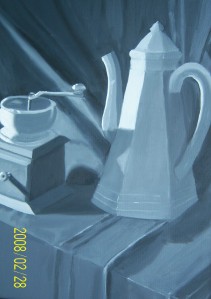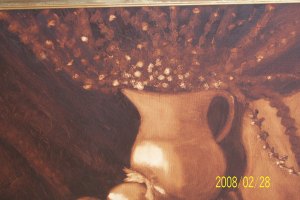March 2013
Fine Art in Oil
A Newsletter For Artists – By Artists Volume 3
By Cassondra Foxpool
The Grisaille
The classes I take at Relis Art Studio are held once a week for three hours. That gives me a lot of time between classes to think. I was thinking I needed to study up on and practice drawing. I was thinking about the things Linda needed to correct me on, in the drawing phase of this project.
I got a few books from the library on drawing. I sketched at home every night. That’s not the same as doodling. You have to actually be able to identify what you draw when you are finished. Over time, I could make better shapes and angles, and even a bit better circles. I learned about perspective and vanishing points. There is so much to learn about composition. But for now, Linda was doing all the set-ups for us, so the importance of composition hadn’t entered my mind yet.
If you are a true novice, as I was, you will find that outside, independent study is very helpful. Nevertheless, the most important and long lasting instruction came from Linda. Sometime I still find myself seeing one thing and drawing something else. I might see a slanted line in some object and draw it in as a straight line. When this happens, I can’t say if I was in a hurry or if my mind was just lost in space somewhere. The mistake will make a difference in the project at some point and willneed corrected but, I always wonder how I could have drawn a horizontal line when it is clearly diagonal. So I’ll try to slow down and concentrate better. Maybe this happens to everyone on occasion, but I mentally beat myself up when I do it myself.
I entered class this time with a bit more confidence in my drawing skills, if not my painting skills. Linda still had her work cut out for her as she shows us ways to understand how to replicate what we are viewing; ways to make it three dimensional. I was looking at the folds on the draped cloth in the background and having difficulty transferring what I saw to my canvas. I found out I wasn’t the only one with this problem.
“O.K.” Linda said, “I see you’re all having trouble with the folds in the background. Think of a wave. It has a front leading edge, a trailing edge and the peak. The fabric has three planes also- two sides and a top.” She explained that the leading edge was the side nearest the light and usually was fairly well lit. The trailing edge was behind the fold and was typically darker. The top gets the most light and is the lightest value of the three sides. “Use your value scale to determine the values of each side,” she reminded us. I dutifully put in the three different values and …. it looked like a childish drawing of sunrays coming down my canvas.
Linda told us how we need to blend the edges of any areas where two different values meet. This is called softening the edge. With the backdrop, she had to also explain about the direction the light flowed over the fold and that blending should be done in that rounded hilltop direction. This requires a bit of practice to perfect. I guess this is what distinguished it from work you see in a coloring book. I find that the sable brushes work best for me in blending. Do you have a favorite brush, make, size or shape brush for different tasks? I’d love to hear your opinions on this.
By the time we finished this painting, I was ready to get some color in my world. Linda told us she painted, for an entire year, in grey values during her art education. No wonder she is so good at it!
As I explained in my last newsletter, doing an entire painting in values of grey is not only called monochromatic, but is more specifically, a grisaille. (pronounced griz eye’) It took me several more weeks in class to complete this painting. With all I learned over the course of those weeks, I definitely felt closer to being an artist. But there was so much more to learn.
At last I had another painting to show for my efforts. I have to admit I was quite proud of it. My husband felt it was worth the work …. and the wait.
Hurray! We are going to use colors next time!
I mistakenly told you in my second news letter that there was a cup in this setup. As you can see, that was my error. No cup.
Below is a photo of that painting. It is titled
Early Morning Grind
The date on this photo is not when I painted it. It is when the photo was taken.
I later sold this painting in a raffle.
View Finder
http://foxpoolsartstudio.weebly Foxpool Online Studio
http://cfoxpool/2013/02/12/the-making-of-an-artist-2 Volumn 1 – Feb. 2013 (in case you missed my very first newsletter)
http://www.relisart.com – Linda Relis


